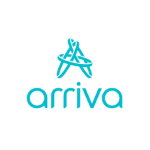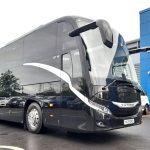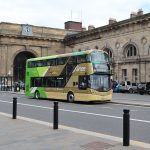New system sees wing mirrors replaced with cameras for greater visibility, safety and security
There are many benefits to investing in new safety and security technology onboard fleets and in depots, with many of the pros outweighing the cons.
The investment in new on-board security and surveillance technology can at times be difficult to justify, but, the advantages of such investments are clear for many.
Iain Stringer, Synectics Mobile Divisional Director, explains that latest generation on-board surveillance and security systems can help prevent false claims such as ‘crash for cash’ and driver-passenger disputes.
In this age where ‘where’s there blame, there’s a claim’, installing security cameras or taking safety to the next level with systems such as MirrorEye, could make a huge difference.
What is MirrorEye?
Synectics is a market leader in on-board surveillance, safety and security, the latest innovation to join its safety portfolio is MirrorEye.
This system replaces traditional mirrors with two purpose-built digital cameras, and screens are placed inside the vehicle which the driver can see easily. With the optimum positioning of the monitors it means that every driver always has a good view.
Synectics is working with partner Orlaco to roll this out and has recently installed the system on an Alexander Dennis (ADL) Enviro400ev which will feature the new technology.
“This is something that will demonstrate not only the latest in emission-free technology from ADL, but also the latest generation in safety and security.”
While Synectics has been working with ADL, the design of the MirrorEye camera units is universal, making MirrorEye suitable for any type of coach or bus. Only the mountings between the MirrorEye camera units and the body of the bus or coach are vehicle-specific, Orlaco says.
Why swap the mirrors?
Last year, the Mayor of London was asked how many pedestrians were struck by bus wing mirrors. Transport for London reviewed its data to identify instances where someone had come into contact with a mirror, resulting in injuries.
From 2015-2017, 209 pedestrians were struck by bus wing mirrors, and the number of injuries increased year on year until 2018: 2014/15, 14 injuries; 2015/16, 80; 2016/2017, 67; and 2017/18, 48.
It’s unknown how these accidents occurred, but it’s clear from the evidence that steps need to be taken to reduce and prevent them from happening again.
MirrorEye, Iain says, is more compact than traditional mirrors so reduce the chances of collision with pedestrians and street furniture. They sit just 12cm from the body.
Safety first
Iain explains that the mirror replacement systems form part of Transport for London’s (TfL) Vision Zero – an initiative that is committed to ending the toll of deaths and injuries seen on roads and transport networks. The goal is that, by 2041, all deaths and serious injuries will be eliminated from London's transport network.
“One of the elements in bus safety is to develop a world-leading safety standard across London’s entire bus fleet, removing exterior mirrors and replacing them with camera systems is a key part of the strategy to deliver this,” Iain says.
“As part of TfL’s Bus Safety Roadmap for new build buses, Class II and blind spot camera monitoring systems such as MirrorEye are required to be fitted on all new London buses from 2021.
“Given our long association with camera systems for London’s bus fleet, it was a natural progression to start looking seriously at this technology, with ADL leading the way.”
The cameras are mounted on the side of the body of the bus. Orlaco says this is a big difference compared to conventional mirrors, which are installed at an angle to the windscreen and protrude significantly.
Benefits
There are clear safety benefits to installing the system, Iain says, but, innovative safety technology like MirrorEye obviously cost more than fitting traditional mirrors.
As well as having the aim to reduce injuries, MirrorEye possesses many other safety benefits.
Unlike traditional mirrors, the cameras will adjust to light and will provide a detailed image, even when faced with low sun, rain, snow and dust. And Iain says the in-built infra-red capability in the cameras will give much better views in dark conditions compared to conventional mirrors.
The cameras will adjust between light and dark conditions in tunnels and are fully-functional in all weather conditions.
Key MirrorEye benefits include:
- Greater field of view and elimination of blind spots (Class II, IV and optional Class V capability)
- Fully certified by the VCA to meet Regulation 46
- Removes sun reflections and light glare
- Improves visibility in wet conditions and enhanced IR capability for dark conditions
- Reduced fuel consumption from aerodynamic design.
MirrorEye’s Future
Currently, Synectics is working MirrorEye with ADL and it is only available on new-build vehicles.
Operators can speak to Synectics or ADL and can be specified as part of the new vehicle build. It’s all done at first build.
“We’ve just fitted the MirrorEye system to an ADL E400ev for London which is in build right now. “We’re now looking at future contracts with ADL and interested operators across the UK & Ireland, with more orders on the way for later in the year.
Adding recording capability to the MirrorEye system is a high priority for future development, to integrate the camera system with Synectics’ recording systems so it can record the views and help reduce the overall camera count.
























